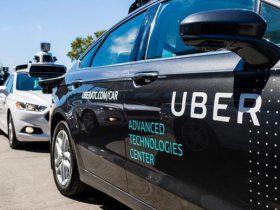Chinese technology company Baidu Inc. is one of the world’s leading developers of autonomous driving technology with its open Apollo platform. In addition to developing an entire mobility ecosystem in China around self-driving vehicles, the company is working directly with three of China’s biggest automakers to install its autonomous driving hardware during the production phase, as opposed to modifying the vehicles after assembly.
The vehicles are being mass produced by the three of China leading automakers, GAC, WM Motor and SAIC Group, to serve as robotaxis for Baidu’s “Apollo Go” ride-hailing service.
On Oct 26, Baidu launched the third of these “Apollo Moon” robotaxis based on an electric SUV from AION, the new electric sub-brand of Chinese automaker GAC which launched in 2018. The EV comes with Baidu’s factory-installed autonomous driving system and is referred to by Baidu as the “Apollo Moon AION version”.
The Apollo Moon AION SUV is built on the latest version of GAC’s GEP (GAC Electric Platform), which is designed for purely electric vehicles. It will accelerate the application of L4 autonomous driving and drive the era of shared mobility, according to Baidu.
“The launch of Apollo Moon is an important breakthrough signifying the powerful linkage between China’s leading autonomous driving technology and the most advanced smart vehicle platform, marking a landmark step in the field of robotaxi ride-hailing services globally,” said Li Zhenyu, senior vice-president at Baidu.
The AION robotaxi is the third production vehicle from three different automakers that Baidu has added its autonomous driving hardware to. The other two are the Apollo Moon Arcfox from automaker BAIC Group’s electric sub brand Arcfox, which was released in June, and the Apollo Moon WM Motor, which is based on the W6 SUV from chinese automaker WM Motor. The W6 was officially launched on Oct 19.
The W6 from WM Motor is equipped with 12 cameras, 5 millimeter-wave radars and 12 ultrasonic radars with L2+ autonomous driving capabilities. Baidu says its Apollo platform supports autonomous driving in dense urban areas as well as highway driving.
Integrating Baidu’s Apollo autonomous driving technology in a production vehicle involved an R&D investment of 3 billion yuan ($469.91 million), according to Chinese news outlet Gasgoo. The platform features both autonomous driving software and hardware integration.
The Apollo Moon AION includes a customer-built LiDAR unit, a fully redundant design for added safety. If any sensors fail, the entire vehicle still executes autonomous driving commands and delivers passengers to a safe dropoff location.
Since its based on a dedicated EV platform that supports better hardware integration, the Apollo Moon AION features lower manufacturing cost per car than that of the former-generation cars, while its overall autonomous driving capabilities have been improved.
Baidu’s Apollo Moon vehicles also use its “ANP-Robotaxi” architecture, which can reduce the weight of autonomous vehicle hardware. The platform can be used to share intelligent driving vehicle data with other Apollo Moon vehicles to create a closed-loop information ecosystem that allows for level-4 autonomous driving, which has not yet been achieved by the industry.
Apollo Moon also includes a precise failure detector and degradable processing algorithms, 5G-powered remote monitoring services and vehicle-to-everything (V2X) technology.
Baidu plans to work with other automakers in the future to install its autonomous driving system in a higher number of vehicles at the factory. Baidu plans to have its Apollo intelligent driving solutions available in more than one million vehicles in the next three to five years, said Li Zhenyu, senior corporate vice president at Baidu, during a presentation in April at Auto Shanghai 2021.
Baidu’s Approach to Self-Driving Differs From Tesla and Waymo in the U.S.
Baidu’s approach in the development of its self-driving technology differs from that of Tesla and Alphabet’s autonomous driving division Waymo, which spun out of Google’s self-driving car project.
Speaking at the Emerging Engineering International Forum 2021, hosted by Peking University last week, Baidu CEO Robin Li spoke about the engineering mindset that drives Baidu’s business.
In his speech, Li shared his thoughts on how competitors like Waymo and Tesla approach the development of autonomous driving technology compared to Baidu.
According to Li, Waymo’s approach is a “scientific one”, aiming to achieve L5 first, then expanding, scaling and commercializing the technology. Tesla however, has taken an “engineering approach”, by gradually making incremental advances in its self-driving technology. Baidu has instead prioritized expanding the driving range of self-driving vehicles, by perfecting the technology in a smaller geo-fenced area before expanded to a wider region.
Li said in his speech that its impossible to deploy a self-driving car on the road and immediately be able to drive all 5 million kilometers of road in China. He says there are many factors that need to be tested and considered prior to achieving the highest level of safety for autonomous vehicles.
By practicing the operation of self-driving cars in smaller areas where the conditions are more conducive to testing, Baidu argues that its able to gradually learn and improve its autonomous driving capabilities before expanding to a wider geographical area.
Baidu is often referred to as the “Google of China”, has been working to deploy commercial autonomous driving technology at scale as part of its open Apollo platform since 2017. The Apollo platform is designed to speed up the development of self-driving technology through collaboration with industry partners.
Since its launch, Apollo’s development work has grown significantly. Baidu is working with over 200 industry partners as part of Apollo, including automakers BMW, Daimler and Volkswagen, and hardware manufacturers Intel and Nvidia.
The Apollo platform is often referred to as the “Android of the Automotive Industry.” It’s the largest open-source autonomous driving platform in the world, according to Baidu.
Baidu called the integration of its autonomous driving technology in the three Apollo Moon robotaxis “a monumental milestone in the large-scale commercialization of fully autonomous ride-hailing services in China.”
During the company’s annual Baidu World 2021 conference in August, Li unveiled his vision for mobility of the future in the form of a futuristic “robocar” designed to make autonomous vehicles more accessible to the broader public.
The robocar features automated gull-wing doors and a transparent glass roof to make the interior feel more spacious for passengers. Each vehicle includes a suite of external sensors for safe navigation on public streets. Baidu says its robocar is capable of level 5 autonomous driving, meaning that no human intervention is ever required.
The over design of the robocar is bold and differs from traditional vehicle designs, with no steering wheel, pedals or other controls for a human operator.
Link: https://www.futurecar.com/4960/Chinas-Baidu-is-Turning-Production-Vehicles-into-Robotaxis-With-its-Factory-installed-Autonomous-Driving-System
Source:https://www.futurecar.com
















Leave a Reply